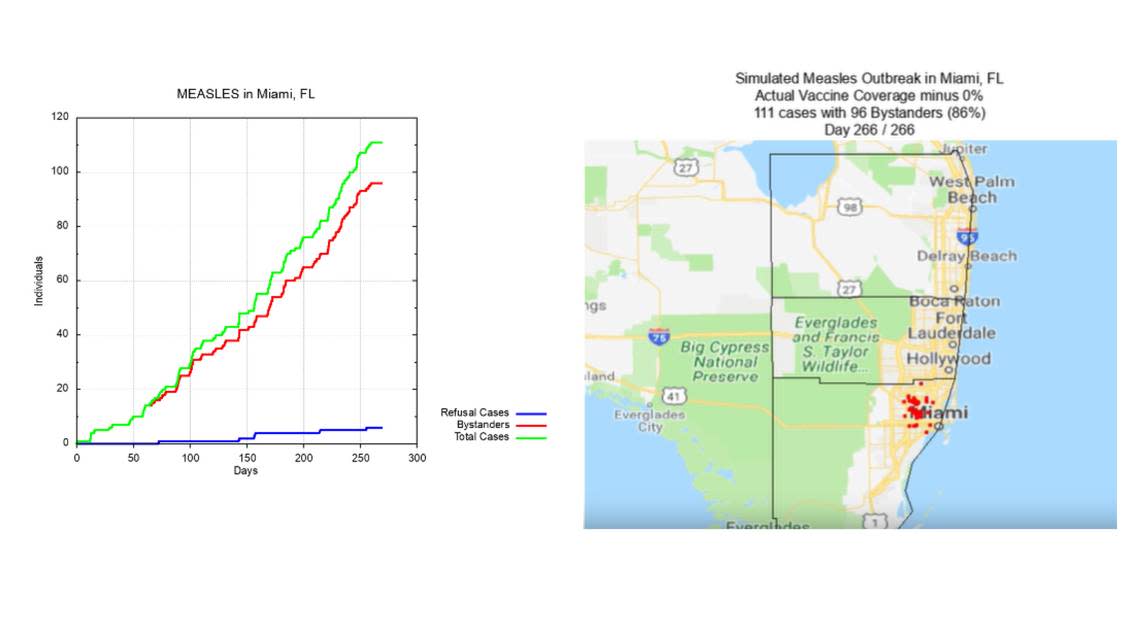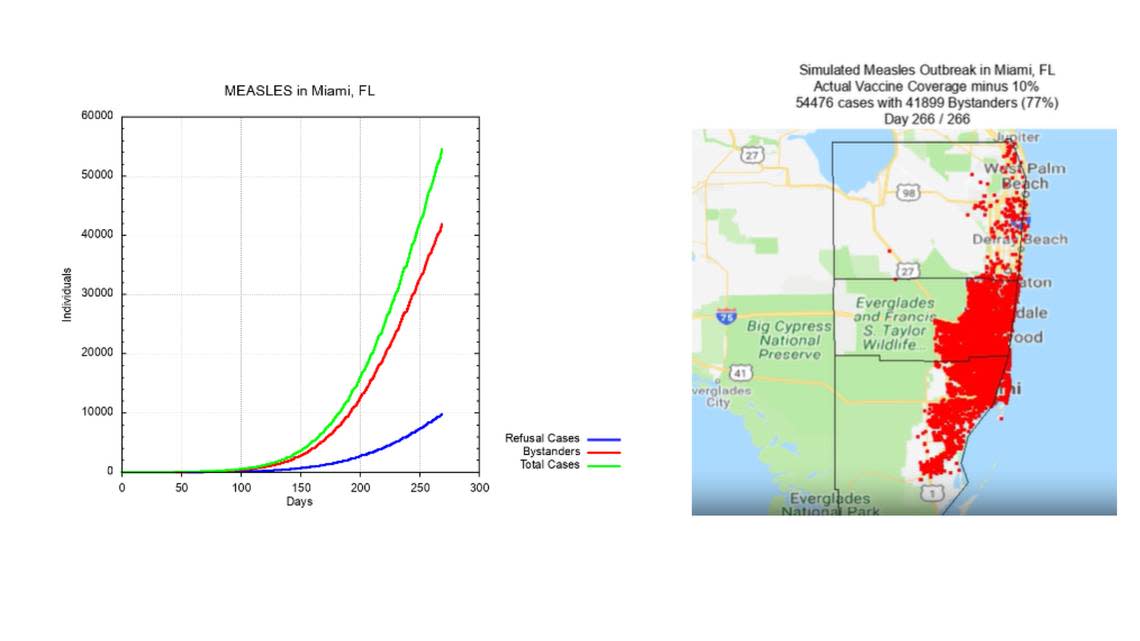How quickly could measles outbreak spread? Here’s what ‘worst-case scenario’ looks like
How quickly could measles actually spread in South Florida?
An outbreak of the highly contagious disease in the Miami-Fort Lauderdale-West Palm Beach metro area could see more than 100 people, or possibly thousands, infected within nearly nine months, depending on how many people lack immunity, either because they weren’t vaccinated or haven’t been previously infected.
This is according to a computerized model built by Dr. Mark Roberts and his team at the University of Pittsburgh and Karen Liller, Ph.D., of the University of South Florida in Tampa.
The online simulator, which was rolled out in 2019, uses a variety of data, including 2017-2018 school vaccination rates for seventh-grade students in Florida. The model demonstrates what could happen in “one out of 20 outbreaks” — a worst case scenario — if a student with measles were to attend school in a Florida metropolitan area and no vaccination programs, quarantine and isolation procedures were implemented, according to Roberts and Liller.
What the Florida measles simulator shows for Miami area
In the 2017-2018 school year, Broward and Palm Beach counties had a vaccination rate of school-required shots of nearly 97% and 95%, respectively, among seventh-graders in public and private schools, meeting or surpassing the 95% threshold recommended by the World Health Organization for herd immunity, state data shows. Miami-Dade County’s vaccination rate among seventh graders in public and private schools was just under the threshold, at 94%.
However, each school has its own vaccination rate. And while some schools might have met the recommended 95% vaccination threshold, others have fewer vaccinated students, meaning a higher measles spread risk.
To develop the model of the Miami-Fort Lauderdale-West Palm Beach metro area, researchers used U.S. Census population data and the “average vaccination rate of seventh graders in each county,” with rates for public and private schools calculated separately. They also used size and location of every school and business in the counties.
The results?
A child with measles in South Florida could lead to an outbreak of 111 cases among adults and children in the county within a span of nearly nine months in a worst-case scenario, the model predicts.

While there would be some cases among students whose parents refused to vaccinate them, about 86% of infections would be among “bystanders.” This includes unvaccinated adults, as well as adults and kids who cannot get vaccinated because of a medical condition or who did get the vaccine but did not build enough immunity.
”One out of 20 times it would be worse than that, and 19 out of 20 times it would be less than that,” said Roberts.
Measles quickly spreads
Measles is a highly contagious disease that spreads through respiratory droplets released by coughing and sneezing. The virus can live for up to two hours in the air after an infected person leaves an area, according to the U.S. Centers for Disease Control and Prevention. While infection is rare for the vaccinated, about 90% of people without immunity will be infected if exposed to the disease, the CDC says.
Two doses of the measles, mumps and rubella vaccine, or MMR, are about 97% effective in protecting someone against measles, though about 3% of people who get vaccinated do not build enough immunity, the public health experts said.
The model also shows what would happen if the vaccination rate in all South Florida schools decreased by 10%. Under this simulation, cases would balloon, with the model bathing the counties in red measles dots. The simulator estimates there could be 54,476 cases of measles recorded in nearly nine months in a worst-case scenario, with 77% of the cases in people who don’t have immunity.

“The purpose isn’t, was never to scare people ... the purpose was to educate and to show you this could happen. It’s a plausible outcome,” said Liller. “Will this happen for sure? No, no one knows.”
But given how Florida’s vaccination rate among children is decreasing, “you inch a little bit closer to how bad this could really be.”
READ NEXT: What should parents do about school during a measles outbreak? Here is the guidance
What is the current school vaccination rate in Florida?
About 94% of seventh graders in Florida completed the mandatory vaccinations needed for school, including the MMR vaccine, for the 2021-2022 school year, according to the most recent school immunization report available online through the Florida Department of Health. This is just below the 95% threshold recommended by the WHO.
Florida for several years had a vaccination rate of 95% or higher among seventh graders until COVID-19 struck in March 2020.
The Broward seventh-grade vaccination rate hit the 95% threshold for public and private schools in the 2021-2022 school year, according to the most recent countywide data available. Miami-Dade and Palm Beach remained below the threshold, with nearly 94% and nearly 93% immunization rates, respectively, for seventh graders in public and private schools in the 2021-2022 school year.
The vaccination rate is lower among kindergarten students in Florida schools, mirroring a national trend.
The U.S. has seen a nationwide decline in childhood vaccinations since the COVID pandemic, an alarming trend that could increase the “risk of outbreaks of vaccine-preventable diseases,” according to the CDC.
And measles outbreaks are continuing to emerge across the country. The U.S. has recorded 41 measles cases within the first two months of 2024, as of the CDC’s March 1 update. Ten of the cases were recorded in Florida in February. Nine of the infected are children who live in Broward County and seven of them are students at Manatee Bay Elementary school in Weston. The other measles case is an adult in Polk County, Central Florida.
READ MORE: Another child has measles in South Florida. Here’s a breakdown of the cases so far
Now that there’s a measles outbreak in Florida, Roberts and Liller are considering updating their simulator to show the measles risk in Florida post-COVID pandemic. For now, they’re hoping the current simulation will continue to help spread awareness about the importance of vaccination.
“My hope would be they see this simulator and think not only for their own health or their children’s health but the health of other children as well ... we need to take politics out of this and we need to look at this as a true public health issue,” said Liller.
To see a simulation of how fast measles could spread in other parts of Florida, visit https://fred.publichealth.pitt.edu/florida_measles
